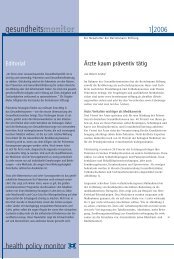The 2nd HPD report - Health Policy Monitor
The 2nd HPD report - Health Policy Monitor
The 2nd HPD report - Health Policy Monitor
- TAGS
- health
- policy
- monitor
- www.hpm.org
You also want an ePaper? Increase the reach of your titles
YUMPU automatically turns print PDFs into web optimized ePapers that Google loves.
<strong>Health</strong> and Aging<br />
Long life expectancy is one of the 20th century’s greatest achievements.<br />
Yet the very success of increasingly large numbers of<br />
people living to a respectable seniority raises challenging questions<br />
for communities and policy makers (cf. table 1). Throughout<br />
the world, the proportion of older people (65 years or older), and<br />
especially that of the oldest old (aged 80 or older), is growing<br />
faster than that of any other age group. This increase does not<br />
only result from prolonged life expectancy but also from decreasing<br />
fertility rates—a double effect from economic growth, improved<br />
living conditions and female education not confined to<br />
developed countries.<br />
Table 1: Percentage of old and oldest old in population,<br />
<strong>Health</strong> <strong>Policy</strong> Network countries, 2000<br />
Country Persons ><br />
65 years<br />
(x 1000)<br />
> 65 as<br />
percentage<br />
of total<br />
population<br />
Persons ><br />
80 years<br />
(x 1000)<br />
> 80 as<br />
percentage<br />
of total<br />
population<br />
Australia 2,379 12.4 562 2.9<br />
Austria 1,257 15.5 287 3.5<br />
Canada 3,854 12.5 910 2.9<br />
Denmark 791 14.8 211 4.1<br />
Finland 772 14.9 174 3.4<br />
France 9,466 16.1 2,206 3.7<br />
Germany 13,523 16.4 3,011 3.7<br />
Japan 22,043 17.4 4,856 3.8<br />
21






